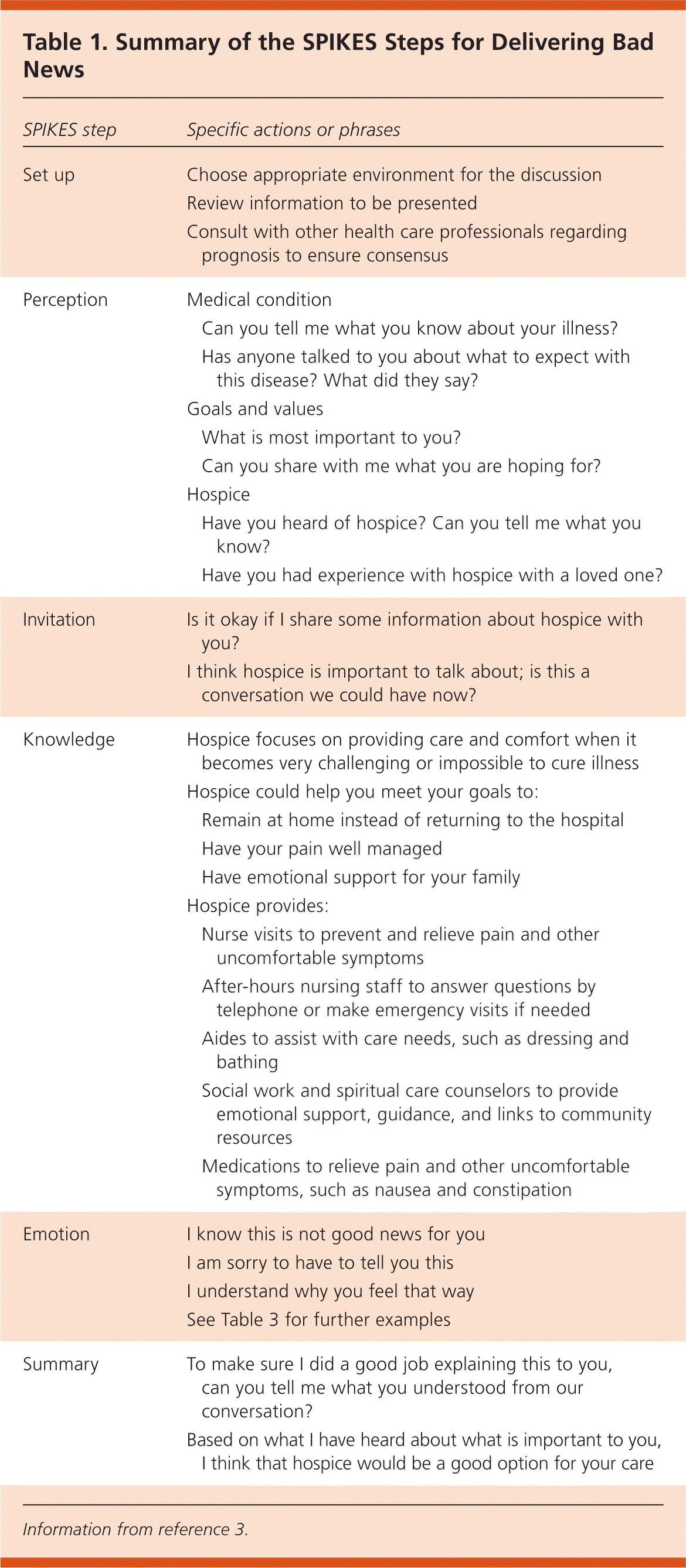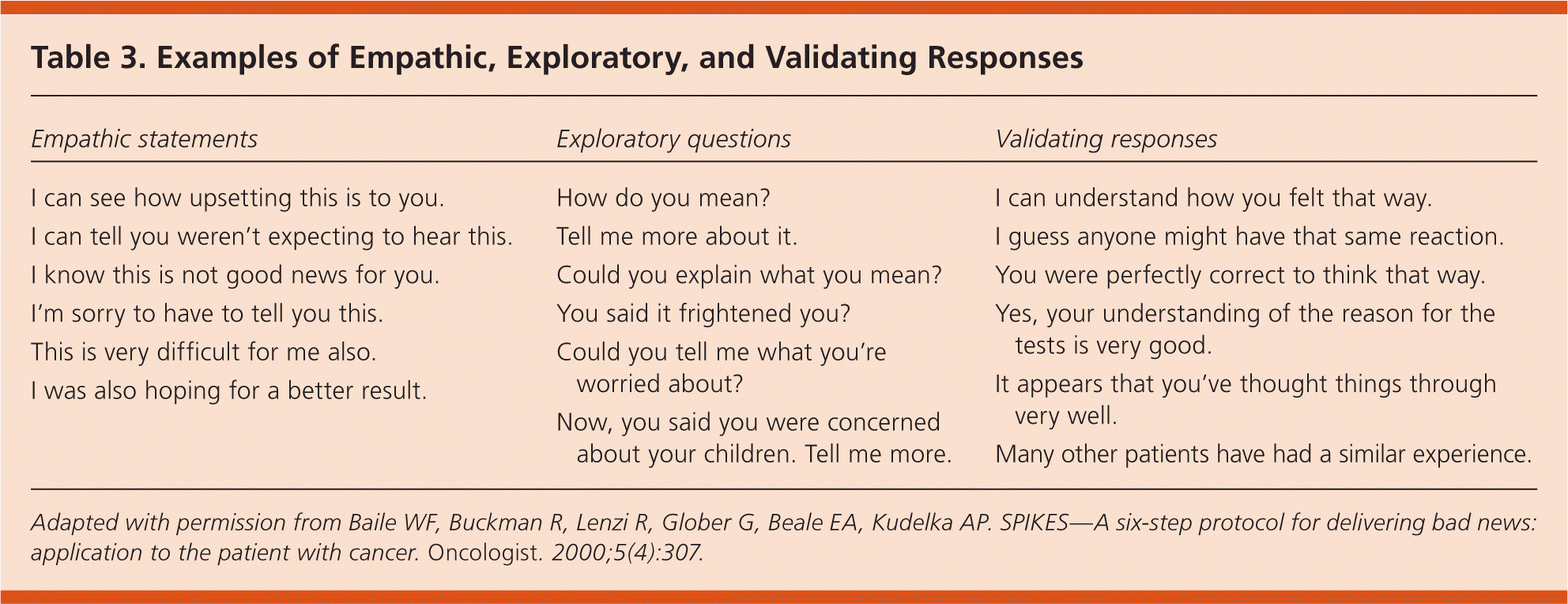
Am Fam Physician. 2014;89(9):745-747
Related article: Diagnosis and Management of Pancreatic Cancer
Author disclosure: No relevant financial affiliations.
Case Scenario
A 70-year-old patient was recently diagnosed with metastatic pancreatic cancer. We determined that hospice care is an appropriate treatment option. What are some tips for discussing hospice with him?
Commentary
Hospice is a program of care and support for persons facing life-limiting illnesses. Hospice care involves a team-oriented approach to medical care, pain management, and emotional and spiritual support expressly tailored to the patient's needs and wishes.1 Most caregivers and families of patients who have received hospice care report that they would have welcomed more information about hospice from their primary care physician at the time the diagnosis was labeled terminal.2 One significant barrier to hospice referral is physician discomfort in communicating a terminal diagnosis and prognosis.2
Although discussing hospice can be more complex than delivering bad news, the tools developed for communicating serious news can be adapted to aid clinicians in this process. One such tool is the SPIKES protocol for delivering bad news (Table 1).3 The protocol is comprised of six communication steps summarized by the mnemonic SPIKES: set up, perception, invitation, knowledge, emotion, and summary.

| SPIKES step | Specific actions or phrases | |
|---|---|---|
| Set up | Choose appropriate environment for the discussion | |
| Review information to be presented | ||
| Consult with other health care professionals regarding prognosis to ensure consensus | ||
| Perception | Medical condition | |
| Can you tell me what you know about your illness? | ||
| Has anyone talked to you about what to expect with this disease? What did they say? | ||
| Goals and values | ||
| What is most important to you? | ||
| Can you share with me what you are hoping for? | ||
| Hospice | ||
| Have you heard of hospice? Can you tell me what you know? | ||
| Have you had experience with hospice with a loved one? | ||
| Invitation | Is it okay if I share some information about hospice with you? | |
| I think hospice is important to talk about; is this a conversation we could have now? | ||
| Knowledge | Hospice focuses on providing care and comfort when it becomes very challenging or impossible to cure illness | |
| Hospice could help you meet your goals to: | ||
| Remain at home instead of returning to the hospital | ||
| Have your pain well managed | ||
| Have emotional support for your family | ||
| Hospice provides: | ||
| Nurse visits to prevent and relieve pain and other uncomfortable symptoms | ||
| After-hours nursing staff to answer questions by telephone or make emergency visits if needed | ||
| Aides to assist with care needs, such as dressing and bathing | ||
| Social work and spiritual care counselors to provide emotional support, guidance, and links to community resources | ||
| Medications to relieve pain and other uncomfortable symptoms, such as nausea and constipation | ||
| Emotion | I know this is not good news for you | |
| I am sorry to have to tell you this | ||
| I understand why you feel that way | ||
| See Table 3 for further examples | ||
| Summary | To make sure I did a good job explaining this to you, can you tell me what you understood from our conversation? | |
| Based on what I have heard about what is important to you, I think that hospice would be a good option for your care | ||
SET UP
Adequate preparation for the hospice discussion can ensure that it goes smoothly. Preparation should include setting up an appropriate environment for the discussion and reviewing pertinent information.
Creating an environment conducive to the hospice discussion involves setting aside adequate time, encouraging the patient to invite others (e.g., family, caregivers, surrogate decision makers) to be present, and minimizing interruptions during the appointment.
Clinicians should be prepared to answer questions about the average time a person with the given illness lives (offered as a range, such as weeks to months), how the illness progresses, and what symptoms may need to be aggressively palliated. Before speaking with the patient, it is important to communicate with other physicians and medical team members to come to a consensus regarding prognosis and appropriate treatment options. Resources are available to help determine prognosis and hospice eligibility, and to explain services provided by the Medicare hospice benefit (Table 2).

| Topic | Resource | Description |
|---|---|---|
| Prognosis | http://eprognosis.ucsf.edu | Website to inform clinicians about possible mortality outcomes |
| Hospice eligibility | http://www.cgsmedicare.com/hhh/coverage/Coverage_Guidelines/LCD.html | Websites to aid in determining Medicare hospice benefit eligibility according to geographic region |
| http://www.palmettogba.com/HHH/LCD | ||
| Medicare hospice benefit services | http://www.medicare.gov/pubs/pdf/11361.pdf | Pamphlet for patients and caregivers describing the Medicare hospice benefit |
| http://www.medicare.gov/pubs/pdf/02154.pdf | Comprehensive booklet for patients and caregivers describing the Medicare hospice benefit |
PERCEPTION
The second step of the protocol involves eliciting the patient's perception of his condition and helping clarify his goals and values.
This step implements the axiom “before you tell, ask.” 3 Before discussing hospice, ask open-ended questions to determine the patient's understanding of the prognosis: “Has anyone talked to you about what to expect with this disease? What did they say?” If the patient wants to know how long he will live, an effective approach is to say, “I will answer that and all of your questions honestly today. First, though, I'm wondering what you are most concerned about when you ask that.” Sometimes patients have particular goals, such as being alive for a wedding or graduation, or fears, such as concerns about leaving loved ones behind.
If the patient does not understand his prognosis, spend time clarifying his understanding rather than continuing the hospice discussion. For example, you could say, “I would like to talk with you about what to expect with your illness. Would that be all right with you?” If the patient agrees, then a follow-up question could be, “What kind of information do you want to know about the future? Some people like to know the average time a person with this disease lives; others like to know the best- and worst-case scenarios. What would be most helpful to you?” 4
It is equally important to understand the goals and values of the patient and family members. Hospice discussions often involve shifting the emphasis of treatment from curing to caring. Redirecting goals is most successful when clinicians have a sense of what is really important to patients.4 Patients' goals and values can be elicited by asking a question, such as, “Can you share with me what you are hoping for?” Patients may reply, “I hope to live.” Clinicians can respond with an empathic statement that continues to explore the patient's goals, such as, “I want that for you too. Tell me what is most valuable to you right now and makes life meaningful.”
Before sharing information about hospice, it can be helpful to investigate the patient's and family's perceptions of hospice. Asking the patient if he has heard of hospice or has had experiences with hospice services can tell you about the patient's preconceptions and determine if there are any misperceptions that need to be dispelled.
INVITATION
Obtaining the patient's permission by way of an invitation to proceed with the hospice discussion can help gauge how much information the patient wants. Also, it allows the patient to maintain some control over the discussion. After clarifying the patient's perception of hospice, it can be appropriate to say, “I have information about hospice I would like to share with you. Is this a conversation we could have now?”
If the patient does not want to proceed with the conversation, a future appointment could be set to continue the discussion.
KNOWLEDGE
This step involves providing information about hospice services. The main purpose of this exchange is to connect the patient's goals and care needs to the services that hospice can offer, rather than just listing hospice services. You could start by saying, “Hospice focuses on providing care and comfort when it becomes very challenging or impossible to cure illness. Hospice could help you meet your goal to… [stay at home].” To maximize patient understanding, use plain language, give information in small pieces, and periodically check the patient's grasp on the topic.3
EMOTION
Responding to the patient's emotion is not a distinct step in the hospice discussion, but rather a skill the clinician should employ throughout the conversation. Until an emotion is cleared, it will be difficult to go on to discuss other issues.3 Clinicians can respond to a patient's emotions by using empathic, exploratory, and validating responses. Empathic responses support the patient, exploratory questions clarify emotions not clearly expressed, and validating statements let the patient know his feelings are legitimate.3 Combining empathic, exploratory, and validating statements is one of the most powerful ways of providing support; it reduces the patient's isolation, expresses solidarity, and validates the patient's feelings or thoughts as normal.3 Table 3 provides examples of phrases used to deliver bad news that clinicians can adapt to the hospice conversation.3

| Empathic statements | Exploratory questions | Validating responses |
|---|---|---|
|
|
|
SUMMARY
The final SPIKES step involves summarizing the conversation. Asking the patient to summarize what was discussed can allow you to assess his understanding of the conversation. It is highly valuable for clinicians to make a recommendation for hospice when hospice services are consistent with the patient's goals and appropriate to the prognosis: “Based on what I have heard about what is important to you, I think that hospice would be a good option for your care.”
